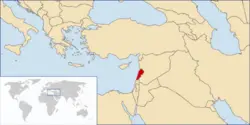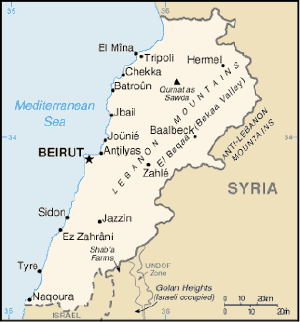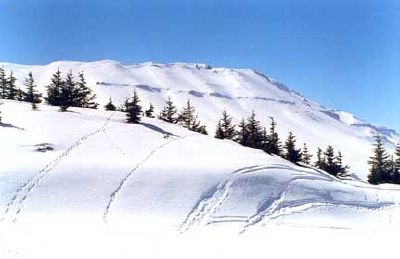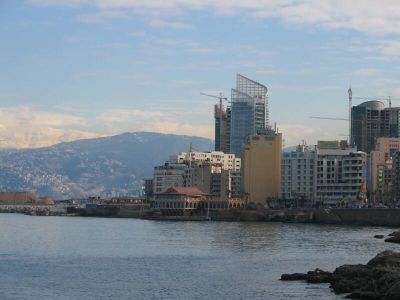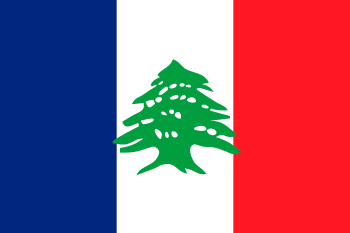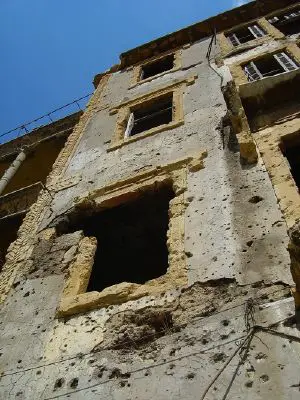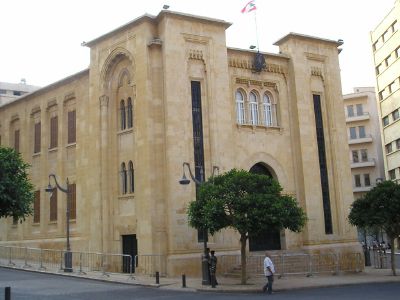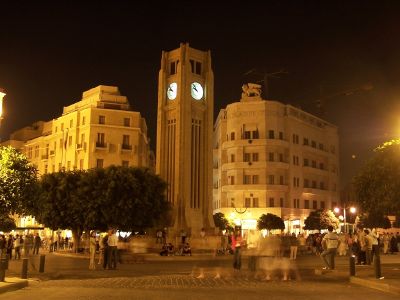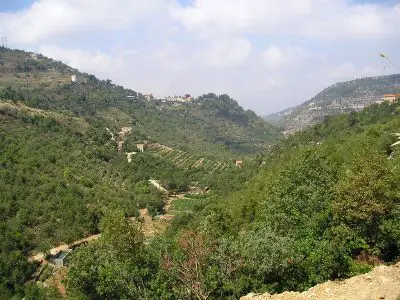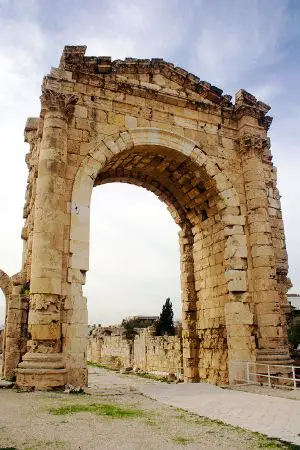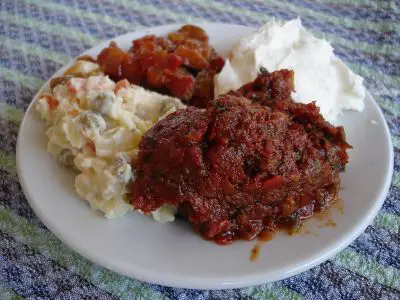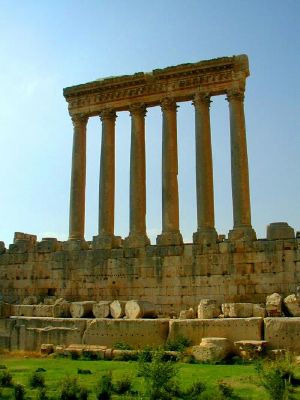Lebanon
| اÙÙÙجÙÙ
ÙÙÙÙرÙÙÙÙØ© اÙÙÙÙÙبÙÙÙاÙÙÙÙÙØ© al-JumhÅ«rÄ«yah al-LubnÄnÄ«yah République libanaise Republic of Lebanon |
||||||
|---|---|---|---|---|---|---|
|
||||||
| Anthem:Â "Lebanese National Anthem" |
||||||
| Location of Lebanon
|
||||||
| Capital (and largest city) | Beirut 33°54â²N 35°32â²E | |||||
| Official languages | Arabic1 | |||||
| Demonym | Lebanese | |||||
| Government | Unitary confessionalist and Parliamentary republic[1] | |||||
| Â -Â | President | Joseph Aoun | ||||
| Â -Â | Prime Minister | Najib Mikati | ||||
| Â -Â | Speaker of Parliament | Nabih Berri | ||||
| Legislature | Chamber of Deputies | |||||
| Independence | End of French League of Nations Mandate | |||||
| Â -Â | Declaration of Greater Lebanon | September 1, 1920Â | ||||
| Â -Â | Constitution | May 23, 1926Â | ||||
| Â -Â | Declared | November 26, 1941Â | ||||
| Â -Â | Recognized | November 22, 1943Â | ||||
| Area | ||||||
|  - | total | km2 km² (166th) 4,036 sq mi |
||||
|  - | Water (%) | 1.8 | ||||
| Population | ||||||
| Â -Â | 2024Â estimate | 5,364,482[2]Â (122nd) | ||||
|  - | Density | 560/km² 1,450/sq mi |
||||
| GDPÂ (PPP) | 2022Â estimate | |||||
| Â -Â | Total | |||||
| Â -Â | Per capita | |||||
| GDP (nominal) | 2022Â estimate | |||||
| Â -Â | Total | |||||
| Â -Â | Per capita | |||||
| Gini (2011) | 31.8[4] | |||||
| Currency | Lebanese pound (LBP) |
|||||
| Time zone | EET (UTC+2) | |||||
|  - | Summer (DST) | EEST (UTC+3) | ||||
| Internet TLD | .lb | |||||
| Calling code | [[+961[2]]] | |||||
| 1Article 11 of the Constitution of Lebanon states that "Arabic is the official national language. A law shall determine the cases in which the French language is to be used." | ||||||
Lebanon (Arabic: ÙبÙا٠LubnÄn), officially the Lebanese Republic (Arabic: اÙج٠ÙÙرÙØ© اÙÙبÙاÙÙØ©), is a small, largely mountainous country in the Middle East, located at the eastern edge of the Mediterranean Sea.
Due to its sectarian diversity, Lebanon follows a special political system, known as confessionalism, meant to distribute power as evenly as possible among different sects.
Until the Lebanese Civil War (1975-90), the country was considered the banking capital of the Arab world and was widely known as the "Switzerland of the Middle East" due to its financial power. Lebanon attracted large numbers of tourists, to the point that its capital, Beirut, was referred to as the "Paris of the Middle East."
By early 2006, extensive efforts to revive the economy and rebuild national infrastructure achieved a considerable degree of stability throughout the country. However, that summer, the 2006 Lebanon War between Israel and Hezbollah, brought significant civilian and military casualties, extensive damage to Lebanon's civilian infrastructure, and massive population displacement. Lebanon is only slowly recovering from the destruction wrought by that war.
Geography
The name Lebanon ("LubnÄn" in standard Arabic; "Lebnan" or "Lebnèn" in the local dialect) is derived from the Semitic root "LBN," which generally means "white" and "milk." This is regarded as reference to the snow-capped Mount Lebanon. Occurrences of the name have been found in three of the 12 tablets of the Epic of Gilgamesh, and the Bible. The word "Lebanon" is mentioned 71 times in the Old Testament.
Lebanon is bordered by the Mediterranean Sea to the west, by Syria to the east and north, and by Israel to the south. The border with the Israeli-occupied Golan Heights in Syria is disputed by Lebanon in a small area called Shebaa Farms, but the border has been demarcated by the United Nations.
Lebanon is a narrow strip of territory approximately 135 miles (215 kilometers) long from north to south and 20 to 55 miles wide from east to west. The country has a total area of 4035 square miles (10,452 square kilometers) making it the 166th largest country in the world, or nearly the size of Connecticut in the United States.
The terrain comprises five ribbon-like topographical areas stretching from North to South. The shoreline, which is 130 miles (210km) long, consists mostly of rocks towards the north, and sand in the south, with some headlands, bays, and offshore islands. The coastal plain is surrounded by sea and mountains, and is rather narrow at about two miles wide. There are the West Mountains, the Beqaa valley, an integral part of Lebanon's agriculture, and the East Mountains. The highest point is Qurnat as Sawda' at 10,131 feet (3,088 meters).
Lebanon has a moderate Mediterranean climate. In coastal areas, winters are cool and rainy while summers are hot and humid. In more elevated areas, temperatures usually drop below 32°F (0°C) during the winter with frequent (sometimes heavy) snow. Summers, on the other hand, are warm at 100° F (38°C) and dry. Although most of Lebanon receives a relatively large amount of rainfall annually (compared to its arid surroundings), certain areas in northeastern Lebanon receive little rainfall because the high peaks of the western mountains block rain clouds from the Mediterranean Sea.
Although there are numerous rivers and streams, none are navigable, and no one river is a source of irrigation water. The Beqaa Valley is watered by two rivers that rise in the watershed near Baalbek: the Orontes flowing north, and the Litani flowing south into the hill region of the southern Beqaa Valley, where it makes an abrupt turn to the west in southern Lebanon and is thereafter called the Al Qasmiyah River.
In ancient times, Lebanon had large forests of Lebanon cedar (the country's national emblem). However, centuries of trading cedar trees, used by ancient mariners for boats, and the absence of efforts to replant them have depleted Lebanon's once-flourishing cedar forests.
Natural hazards include dust storms and sandstorms. Environmental issues include deforestation, soil erosion, desertification, air pollution in Beirut from vehicular traffic, and the burning of industrial wastes, and pollution of coastal waters from raw sewage and oil spills.
Beirut is the capital, largest city, and chief seaport of Lebanon. It is sometimes referred to by its French name, "Beyrouth." There are wide-ranging estimates of Beirut's population, from as low as 938,940 people to 1,303,129 people. Other cities are Tyre, an ancient Phoenician city in the south (population 117,100), and Sidon, another ancient city.
History
Archaeologists have discovered, in Byblos, what is believed to be the oldest continuously inhabited city in the world, remnants of prehistoric huts with crushed limestone floors, primitive weapons, and burial jars which are evidence of the Neolithic and Chalcolithic fishing communities who lived on the shore of the Mediterranean Sea over 7,000 years ago.
The Canaanites
Canaanites were the original inhabitants of the region approximating present-day Israel, the West Bank and Gaza, plus adjoining coastal lands and parts of Lebanon, Syria, and Jordan. Semitic peoples are thought to have appeared in Canaan in the early Bronze Age, before 2000 B.C.E. Semitic people known as the Amorites became the dominant population group during this period, migrating from the northeast. The Israelites, according to the Book of Judges, during the second millennium B.C.E., gradually subjugated the Canaanite cities, so that by the end of the reign of Solomon, king of Israel, the Canaanites had been assimilated. The Canaanite religion itself was based on the worship of Baal and Ashtoreth. Before the Hebrew conquest, it was likely the Canaanites and the Phoenicians constituted a single nation, and that the people now known as the Phoenicians subsequently developed separately.
The Phoenicians
The coastal plain of Lebanon is the historic home of a string of coastal trading cities of Semitic culture, which the Greeks termed Phoenicia, whose maritime culture flourished there from about 2700 B.C.E. to 450 B.C.E. Ancient ruins in Byblos, Beirut, Sidon, Sarepta, and Tyre show a civilized nation, with urban centers and sophisticated arts. The territory was a cosmopolitan center for many nations and cultures. Its people roamed the Mediterranean seas, were skilled in trade and in art, and founded trading colonies. They created the oldest known 24-letter alphabet, a shortening of earlier 30-letter alphabets such as Proto-Sinaitic and Ugaritic.
Phoenicia maintained an uneasy tributary relationship with the neo-Assyrian and neo-Babylonian empires. Cyrus the Great conquered Phoenicia in 539 B.C.E. Phoenicia was divided into four vassal kingdoms by the Persians: Sidon, Tyre, Arwad, and Byblos, and prospered, furnishing fleets for the Persian kings.
Greeks and Romans
Alexander the Great conquered Tyre in 332 B.C.E. by extending a still-extant causeway from the mainland in a seven-month effort. Tyre fell to the Seleucid Empire (323 B.C.E. to 60 B.C.E.) after Alexander's death. The area was conquered by the Roman Empire in the first century B.C.E., was dominated by the Byzantine Empire, which was the Greek-speaking Roman Empire centered around its capital of Constantinople (306 C.E. â 1095 C.E.). Christianity was introduced to Phoenicia from neighboring Galilee soon after the time of Jesus of Nazareth (c.2 B.C.E. to c. 29 C.E.).
Arab rule and the Middle Ages
The Arab advances brought Islam soon after the death of Islam's Prophet Muhammad (c. 570 C.E. to 632 C.E.). Muslim influence increased greatly in the seventh century when the Umayyad capital was established at nearby Damascus. During the Middle Ages, Lebanon was heavily involved in the Crusades. Lebanon was in the main path of the First Crusade's advance on Jerusalem. Later, Frankish nobles occupied present-day Lebanon as part of the southeastern Crusader States. The southern half of present-day Lebanon formed the northern march of the Kingdom of Jerusalem; the northern half was the heartland of the County of Tripoli. Although Saladin eliminated Christian control of the Holy Land around 1190, the Crusader states in Lebanon and Syria were better defended.
Mamluks and Ottomans
Muslim control of Lebanon was re-established in the late thirteenth century under the Mamluk sultans of Egypt. Lebanon was later contested between Muslim rulers until the Ottoman Empire solidified authority over the eastern Mediterranean. Ottoman control was uncontested during the early modern period, but the Lebanese coast became important for its contacts and trades with Venice and other Italian city-states. Lebanon was part of the Ottoman Empire for over 400 years, in a region known as Greater Syria, until 1916.
The mountainous territory of Mount Lebanon has long been a shelter for minority and persecuted groups, including its historic MaroniteChristian majority along with Druze, and local Shi'a Muslims. It was an autonomous Maronite region of the Ottoman Empire.
French mandate
The area became a part of the French Mandate of Syria following World War I. On September 1, 1920, France formed the State of Greater Lebanon as one of several ethnic enclaves within Syria. Lebanon was a largely Christian (mainly Maronite) enclave but also included areas containing many Muslims and Druze. On September 1, 1926, France formed the Lebanese Republic. The Republic was afterward a separate entity from Syria but still administered under the French Mandate for Syria.
Independence
The Vichy authorities in 1941 allowed Germany to move aircraft and supplies through Syria to Iraq where they were used against British forces. The United Kingdom, fearing that Nazi Germany would gain full control of Lebanon and Syria by pressure on the weak Vichy government, sent its army into Syria and Lebanon.
After the fighting ended in Lebanon, General Charles de Gaulle decided to recognize the independence of Lebanon. On November 26, 1941, General Georges Catroux announced that Lebanon would become independent under the authority of the Free French government. Elections were held in 1943 and on November 8, 1943 the new Lebanese government unilaterally abolished the mandate. The French reacted by imprisoning the new government, but bowing to international pressure, released them on November 22, 1943, and accepted the independence of Lebanon.
The allied forces kept the region under control until the end of World War II. The last French troops withdrew in 1946. Lebanon's unwritten National Pact of 1943 required that its president be Christian and its prime minister be Muslim.
1948 Arab-Israeli war
Five years after gaining independence, Lebanon joined its fellow Arab states and invaded Israel during the 1948 Arab-Israeli War. It took over logistical support of the Arab Liberation Army after it found itself cut off from its bases in Syria while attempting an attack on the newly proclaimed Jewish State. After the defeat of the Arab Liberation Army in Operation Hiram, Lebanon accepted an armistice with Israel on March 23, 1949. Approximately 100,000 Palestinian refugees were living in Lebanon in 1949 as a result of the creation of Israel and the subsequent war. The Lebanese-Israeli border remained closed, but quiet, until after the Six Day War in 1967.
Civil war
In 1975, civil war broke out in Lebanon, and lasted 15 years, devastating the country's economy. It is estimated that 150,000 people were killed and another 200,000 maimed. The war ended in 1990 with the signing of the Taif Agreement with parts of Lebanon left in ruins. During the civil war, Lebanon was invaded and occupied by the Israel Defense Forces in 1978 and 1982. Israel remained in control of Southern Lebanon until 2000, when Israeli Prime Minister Ehud Barak decided to withdraw due to continuous guerrilla attacks by Hezbollah militants and a belief that Hezbollah activity would diminish and dissolve without the Israeli presence. The UN determined that the withdrawal of Israeli troops beyond the Blue Line was in accordance with UN Security Council Resolution 425, although a border region called the Shebaa Farms remained in dispute. Hezbollah declared that it would not stop until this area was liberated.
Assassinations
On February 14, 2005, former Prime Minister Rafik Hariri was assassinated in a car bomb explosion. Leaders of the March 14 Alliance accused Syria of the attack, due to its extensive military and intelligence presence in Lebanon, and the public rift between Hariri and Damascus over the Syrian-backed constitutional amendment extending pro-Syrian President Lahoud's term in office. Syria denied any involvement, claiming that the assassination was executed by the American CIA or the Israeli Mossad in an attempt to destabilize the country. The Hariri assassination marked the beginning of a series of assassination attempts that led to the loss of a number of prominent Lebanese figures.
The United Nations Security Council unanimously adopted Resolution 1595 on April 7, 2005, which called for an investigation into the assassination of Rafik Hariri. The findings of the investigation were officially published on October 20, 2005, in the Mehlis report. The vehicle used for the explosion was a Mitsubishi Fuso Canter stolen in Japan, and was most likely detonated by a suicide bomber. The United Nations Security Council and the Lebanese cabinet have approved a Special Tribunal for Lebanon that would prosecute those responsible for Hariri's death.
Cedar Revolution
The Cedar Revolution was a chain of demonstrations and popular civic action, especially in Beirut, triggered by the assassination of Hariri. On February 28, 2005, with over 50,000 people demonstrating in Martyrs' Square, Prime Minister Omar Karami and his Cabinet resigned. In response, Hezbollah organized a large counter-demonstration attended by hundreds of thousands of people, which was staged on March 8 in Beirut, supporting Syria and accusing Israel and the United States of meddling in internal Lebanese affairs.
On March 14, 2005, one month after Hariri's assassination, one million people rallied in Martyrs' Square in Lebanon demanding the truth about Hariri's murder and independence from Syrian presence in Lebanon. Bombs were detonated in Christian areas near Beirut.
Under pressure from the international community, Syria began withdrawing its 15,000 troops from Lebanon. By April 26, 2005, all uniformed Syrian soldiers had left. On April 27, 2005, the Lebanese celebrated their first free-from-Syria day. UN forces were sent to Lebanon to verify the military withdrawal.
In the elections in May 2005, the anti-Syrian coalition of Sunni Muslim, Druze and Christian parties led by Saad Hariri, the son of assassinated prime minister, won most seats, but did not win the two-thirds majority required to force the resignation of Syrian-appointed President Lahoud. Hariri's Future Movement party nominated Fouad Siniora, a former Finance Minister, to be prime minister. On July 18, 2005, Lebanon elected a new parliament dominated by an anti-Syrian coalition.
2006 Lebanon War
A cross-border Hezbollah raid and shelling of Israel, which resulted in the capture of two and killing of eight Israeli soldiers brought Israeli airstrikes across much of the country on July 12, 2006, and ground incursions into southern Lebanon. The fighting quickly escalated into 33 days of "open war" and ultimately led to the death of 1,191 Lebanese and 44 Israeli civilians.
Fighting came to end on August 14, three days after UN Security Council Resolution 1701âwhich called for an immediate cessation of hostilitiesâwas passed. Israel maintained a naval and aerial blockade on Lebanon to prevent Hezbollah from smuggling arms. The blockade was lifted on September 8, and by early December, all Israeli troops had withdrawn.
Since 2006
In October 2007, Ãmile Lahoud finished his second term as president. The opposition conditioned its vote for a successor on a power-sharing deal, thus leaving the country without a president for over 6 months.
On May 9, 2008, Hezbollah and Amal militants, in an armed attack triggered by a government decision on Hezbollah's communications network, temporarily took over Western Beirut. The situation was described by the government as an attempted coup.
On May 21, 2008, all major Lebanese parties signed an accord to elect Michel Suleiman as President, to form a national unity government with 11 out of 30 seats for the opposition, thus enabling it to veto decisions, and to adopt a new electoral law, based on the 1960 law with amendments for the three Beirut constituencies. The deal was brokered by an Arab League delegation, headed by the Emir and Foreign Minister of Qatar and the Secretary General of the Arab League, after five days of intense negotiations in Doha. Suleiman was officially elected president on May 25, 2008.
In early January 2011, the national unity government collapsed due to growing tensions stemming from the Special Tribunal for Lebanon, which was expected to indict Hezbollah members for the Hariri assassination. The parliament elected Najib Mikati, the candidate for the Hezbollah-led March 8 Alliance, Prime Minister of Lebanon, making him responsible for forming a new government. Hezbollah leader Hassan Nasrallah later accused Israel of assassinating Hariri. A report leaked by the Al-Akhbar newspaper in November 2010 stated that Hezbollah had drafted plans for a violent takeover of the country in case the Special Tribunal for Lebanon issued an indictment against its members.
In 2012, the Syrian civil war threatened to spill over in Lebanon, causing incidents of sectarian violence and armed clashes between Sunnis and Alawites in Tripoli. In 2013, The Lebanese Forces Party, the Kataeb Party, and the Free Patriotic Movement voiced concerns that the country's sectarian based political system was being undermined by the influx of Syrian refugees.
Lebanon was without a president between May 2014 and October 2016, when Michel Aoun became president.
National crisis
On October 17, 2019, the first of a series of mass civil demonstrations erupted; they were initially triggered by planned taxes on gasoline, tobacco, and online phone calls, but quickly expanded into a country-wide condemnation of sectarian rule and failures from the government to provide basic services such as electricity, water, and sanitation. As a result of the protests, Lebanon entered a political crisis, with Prime Minister Saad Hariri tendering his resignation and echoing protestors' demands for a government of independent specialists.
On August 4, 2020, an explosion at the port of Beirut, Lebanon's main port, destroyed the surrounding areas, killing over 200 people, and injuring thousands more. The cause of the explosion was later determined to be 2,750 tonnes of ammonium nitrate that had been unsafely stored, and accidentally set on fire that Tuesday afternoon. Protests resumed within days following the explosion, which resulted in the resignation of Prime Minister Hassan Diab and his cabinet on August 10, 2020, nonetheless continuing to stay in office in a caretaker capacity. Demonstrations continued into 2021.
In May 2022, Lebanon held its first election since a painful economic crisis dragged it to the brink of becoming a failed state. In the election the Shia Muslim Hezbollah movement (and its allies) lost their parliamentary majority. Hezbollah did not lose any of its seats, but its allies lost seats. Hezbollah's ally, President Michel Aoun's Free Patriotic Movement, was no longer the biggest Christian party after the election. A rival Christian party, the Lebanese Forces led by Samir Geagea, became the largest Christian-based party in parliament. The Sunni Future Movement, led by former prime minister Saad Hariri, did not participate in the election, leaving a political vacuum for other Sunni politicians to fill. Lebanon was again without a president from October 2022 until January 2025, when Joseph Aoun (not related to Michel Aoun) was elected president by the Lebanese parliament.
The IsraelâHamas war sparked a renewed IsraelâHezbollah conflict. Hezbollah has said it will not stop attacking Israel until Israel ceases its attacks in Gaza. On October 1, 2024, Lebanon was invaded by Israel with the objective of destroying infrastructure belonging to Hezbollah in the south of the country.
Government and politics
The Lebanese Republic has a parliamentary democracy in which the highest offices are proportionately reserved for representatives from various religious communities to minimize sectarian conflict â a framework known as âconfessionalism.â
The chief of state is the president, who is elected by the National Assembly for a six-year term, and who may not serve consecutive terms. The head of government is the prime minister, who, with the deputy prime minister, is appointed by the president in consultation with the National Assembly. The cabinet is chosen by the prime minister in consultation with the president and members of the National Assembly. By agreement, the president is a Maronite Christian, the prime minister is a Sunni Muslim, and the speaker of the National Assembly is a Shi'a Muslim.
The legislature, the unicameral National Assembly has 128 seats. Members are elected by popular vote on the basis of sectarian proportional representation (divided in half between Muslims and Christians) to serve four-year terms. Those 21 years of age and over have the right to vote, which is compulsory for all males, and authorized for women aged 21 and over with elementary education.
The judiciary comprises four Courts of Cassation (three courts for civil and commercial cases and one court for criminal cases), a Constitutional Council (called for in Ta'if Accord) which rules on the constitutionality of laws, and a Supreme Council, which hears charges against the president and prime minister as needed. Juries are not used in trials. The legal system is a mixture of Ottoman law, canon law, Napoleonic code, and civil law. There is no judicial review of legislative acts, and Lebanon has not accepted compulsory International Court of Justice jurisdiction.
There are religious courts that have jurisdiction on marriage, divorce, and inheritance. Lebanese law does not provide for civil marriage (although it recognizes such marriages contracted abroad). Lebanon has military courts that have jurisdiction over civilians for crimes of espionage, treason, and other security-related crimes. These military courts have been criticized by human rights organizations for "seriously fall[ing] short of international standards for fair trial" and having "very wide jurisdiction over civilians."
Lebanon is divided into six governorates that are further subdivided into 25 districts. The districts themselves are also divided into several municipalities, each enclosing a group of cities or villages.
Lebanonâs sovereignty has been compromised by civil war, foreign occupations, and the activity of terrorist groups.
Military
The military is officially known as the Lebanese Armed Forces (LAF), and consists of three branches: The Lebanese army, navy, and air force. The LAF consists of approximately 72,100 active personnel with the ground forces consisting of approximately 70,000 troops, the air force consisting of approximately 1,100 personnel and another 1,000 in the Navy. All three branches are operated and coordinated by LAF Command, which is located in Yarzeh, just east of the capital, Beirut. There are a total of six military colleges and schools in the country. Some cadets may be sent to other countries to receive additional training.
The equipment inventory of the LAF is outdated due to a lack of funds, lack of foreign investment, political bickering, and the presence of foreign forces. After the conclusion of the Lebanese Civil War the LAF decided to repair as much of its equipment as it could, while being aided by modest donations from other nations. Approximately 85 percent of the LAF's equipment is US-made with the remaining being British, French, and Soviet-made.
Sectarian politics
Dividing state power between the religious sects, and granting religious authorities judicial power, dates back to Ottoman times. The practice was reinforced during French colonialism, when Christian groups were granted privileges. This system of government, while partly intended as a compromise between sectarian demands, has caused tensions that still dominate Lebanese politics. The Christian population majority is believed to have ended in the early 1930s, but government leaders would agree to no change in the political power balance. This led to Muslim demands of increased representation, and the constant sectarian tension slid into violent conflict in 1958 (prompting U.S. intervention) and again in the grueling Lebanese Civil War, in 1975-1990.
The balance of power has been slightly adjusted in the 1943 National Pact, an informal agreement struck at independence, in which positions of power were divided according to the 1932 census. The Sunni elite was then accorded more power, but Maronites continued to dominate the system. The sectarian balance was again adjusted towards the Muslim side - but simultaneously further reinforced and legitimized. Shi'a Muslims (by 2007 the largest sect) then gained additional representation in the state apparatus, and the obligatory Christian-Muslim representation in Parliament was downgraded from a 6:5 to a 1:1 proportion. Christians of various sects were then generally thought to constitute about 40 percent of the population, although often Muslim leaders would cite lower numbers, and some Christians would claim that they still held a majority.
Hezbollah
Hezbollah, literally "party of God," is a Shi'a Islamic political and paramilitary organization based in Lebanon. It follows a distinct version of Islamist Shi'a ideology developed by Ayatollah Ruhollah Khomeini, leader of the Islamic Revolution in Iran. Hezbollah began to take shape during the Lebanese Civil War to eradicate Western colonialism in Lebanon, bring to justice those who committed atrocities during the war (specifically the Phalangists), and to establish an Islamic government in Lebanon. Hezbollah has realized that the goal of transforming Lebanon into an Islamic state was not practical and has temporarily abandoned it. The weakness of central government has enabled Hezbollah to become the de facto government of regions under its control.
Economy
Lebanon was shaped by trade, since the area linked the Mediterranean world, India, and East Asia. Merchants exported oil, grain, textiles, metal work, and pottery through the port cities to Western markets. Nomads of the Syrian and Arabian deserts visited the cities of Syria to trade, developing limited routes that often led to the coastal cities of Tripoli, Beirut, Sidon, or Tyre.
Until the Lebanese Civil War (1975-1990), the country enjoyed relative calm and prosperity, driven by the tourism, agriculture, and banking sectors of the economy. It was considered the banking capital of the Arab world and was widely known as the "Switzerland of the Middle East" due to its financial power. Lebanon attracted large numbers of tourists, to the point that the capital Beirut became widely referred to as the "Paris of the Middle East." But the civil war seriously damaged Lebanon's economic infrastructure, cut national output by half, and all but ended Lebanon's position as a Middle Eastern entrepot and banking hub.
In the years since, Lebanon has rebuilt much of its war-torn infrastructure by borrowing heavily - mostly from domestic banks. In an attempt to reduce the ballooning national debt, the Rafiq Hariri government began an austerity program, reining in government expenditures, increasing revenue collection, and privatizing state enterprises, but economic and financial reform initiatives stalled and public debt continued to grow despite receipt of more than $2-billion in bilateral assistance at the Paris II Donors Conference.
Lebanon has a competitive and free market regime and a strong laissez-faire commercial tradition. Private property is common and encouraged, while the government owns most public services. Land laws resemble those in France and the United States. The Lebanese economy is service-oriented; main growth sectors include banking and tourism. There are no restrictions on foreign exchange or capital movement, and bank secrecy is strictly enforced. Lebanon legislated against money laundering. There are practically no restrictions on foreign investment. There are no country-specific U.S. trade sanctions against Lebanon.
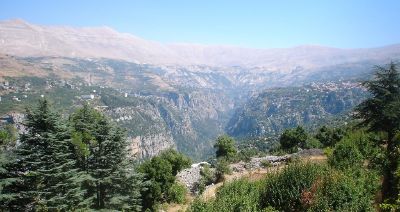
A combination of climate, many historic landmarks and World Heritage Sites attracts large numbers of tourists to Lebanon, despite political instability. In addition, Lebanon's strict financial secrecy and capitalist economyâunique in its areaâhave given it significant economic status among Arab countries. Nearly 65 percent of the Lebanese workforce works in the services sector, which contributes roughly 67.3 percent of the annual Lebanese GDP.
Lebanon is suited for agriculture, as it has water, fertile soil, and has the highest proportion of cultivable land in the Arab world.
Lebanon's lack of raw materials for industry and its dependence on Arab countries for oil have posed difficulties for industrial activity, which is limited to small businesses concerned with reassembling and packaging imported parts.
The Israeli-Hezbollah conflict caused an estimated $3.6-billion in infrastructure damage in July and August 2006, and internal Lebanese political tension continues to hamper economic activity.
Export commodities include authentic jewelry, inorganic chemicals, miscellaneous consumer goods, fruit, tobacco, construction minerals, electric power machinery and switchgear, textile fibers, and paper. Export partners include Syria, United Arab Emirates, Switzerland, Turkey, and Saudi Arabia.
Import commodities include petroleum products, cars, medicinal products, clothing, meat and live animals, consumer goods, paper, textile fabrics, and tobacco. Import partners include Italy, Syria, France, Germany, China, U.S, UK, and Saudi Arabia.
Beirut's airport, Rafiq Hariri International Airport, re-opened in September 2006 and the efforts to revive the Lebanese economy have since been proceeding at a slow pace.
Demographics
About 90 percent of the population of Lebanon is urban and comprises many different ethnic groups and religions. Without accurate figures, it is estimated that there are between five and 15 million people of Lebanese descent spread all over the world, Brazil being the country with the biggest Lebanese community abroad. Argentina, Australia, Canada, Colombia, France, Great Britain, Mexico, Venezuela and the USA also have large Lebanese communities.
Ethnicity
The country encompasses a mix of cultures and ethnic groups built for more than 6,000 years. Although the official language is Arabic, the Arabs only reached Lebanon in the seventh century, and their culture was superimposed on an already diverse ethnic population. Some Lebanese, especially among Maronite Christians, see themselves as descendants of the Phoenicians, Canaanites, Mardaites, and Syriacs. This was supported by genetic studies and tend to de-emphasize or deny Lebanon's Arab heritage. Melkite Greek Catholics, the Greek Orthodox, and some Maronites tend to focus more on the Greek heritage of the region from the days of the Byzantine Empire. Some Christians claim descent from Crusader knights who ruled Lebanon for a couple of centuries during the Middle Ages. This identification with non-Arab civilizations also exists in other religious communities, albeit not to the same extent. Sunni and Alawite Muslim, as well as Greek Orthodox and rural Roman Catholic Christians are believed to be of a mixed Levantine (Syrian/Shami) origin.
Lebanese Armenians, Assyrians, Jews, Kurds and Persians form more distinct ethnic minorities, all of them having a national home territory outside of Lebanon. However, they total less than four percent of the population.
Palestinian refugees, mostly refugees or descendants of refugees from the 1948 Arab-Israeli War remain present in Lebanon. Some may have emigrated during the civil war. The exact number of Palestinians remains in dispute and the Lebanese government will not provide an estimate. Their presence is controversial, and resisted by large segments of the Christian population, who argue that the primarily Sunni Muslim Palestinians dilute Christian numbers. Many Shi'a Muslims dislike the Palestinian presence, since the camps tend to be concentrated in their home areas. Palestinians are not accorded legal rights, are denied citizenship, and confined to severely overcrowded refugee camps. Palestinians cannot work in a large number of professions, as lawyers or doctors. Their sources of income are UNRWA aid and menial labor sought in competition with Syrian guest workers. The Palestinians are mostly Sunni Muslim, but there is also a Christian minority of over 10 percent (primarily Greek Orthodox).
Lebanon holds a large number of Syrian workers, most of whom are employed on a seasonal basis, and who do not hold citizenship. They entered Lebanon mainly after Syria established its controversial occupation there during the Lebanese Civil War. They are employed in menial labor, working in areas such as construction. Their exact numbers are disputed, with Lebanese nationalists tending to give high estimates (up to 1.5 million) while others go as low as 300,000. In 1994, Lebanese authorities - then under Syrian domination - authorized a controversial granting of citizenship to Syrians (and a small number of Palestinians and others) in Lebanon. The precise number is disputed, figures ranging from a 100,000 people to half a million. It seems clear, however, that the act shifted the religious balance in favor of Sunni Muslims, altering the sectarian makeup of Lebanese politics. The Syrians in Lebanon are Arab, and are mainly Muslims of the Sunni sect.
There are substantial numbers of immigrants from other Arab countries, from Indonesia, the Philippines and Malaysia, as well as smaller numbers of other immigrant minorities. Most of these are employed as guest workers. There are approximately 180,000 stateless persons in Lebanon. Many of these are Kurds from Turkey and Syria, or other Syrians.
Religion
Because the matter of religious balance is a sensitive political issue, a national census has not been conducted since 1932, before the founding of the modern Lebanese state. Accurate data on religious-ethnic makeup is lacking. It is estimated that about 40 percent are Christians (mostly Maronites, Greek Orthodox, Armenian Apostolic, Melkite Greek Catholics, Assyrian Church of the East, Chaldean Catholic), 35 percent are Shia Muslims, 21 percent are Sunni Muslims and five percent are Druze. A small minority of Jews live in central Beirut, Byblos, and Bhamdoun. Lebanon has a population of Kurds (also known as Mhallami or Mardinli), of whom are converted Syriacs estimated to be between 75,000 and 100,000 and considered to be part of the Sunni population. Other groups are: Alawite, Armenian Orthodox (Gregorian), Copt, Evangelical Christian (including Protestant groups such as Baptists and Seventh-day Adventists), Isma'ili Roman Catholic (Latins), Syriac Catholic, and Syriac Orthodox.
The Lebanese Constitution acknowledges 18 religious groups. These have the right to handle family law according to their own courts and traditions, and they are the basic players in Lebanon's complex sectarian politics. These groups are not internally homogeneous. For example, the Maronite, Shi'a and Druze communities have been wracked by internal fighting even in recent times.
Language
Lebanon's official language is Arabic, but French, Armenian, and English are widely spoken. Many Lebanese speak a patois of some combination of these four languages, most commonly an Arabic-French mixture. Virtually all Lebanese are bilingual.
Spoken Arabic is one part of a group of dialects called Levantine Arabic, differing greatly from the literary Modern Standard Arabic and owes its historical blend to the Syriac dialect of Aramaic and Arabic. It is a fusion between Syriac and Arabic, as well as some Turkish and thus in this respect can be more correctly classified as a separate language from Arabic.
Due to the importance of the Lebanese diaspora and business interests of Lebanese worldwide, it has always been important to master languages other than Arabic. Many of Lebanon's best educational institutions have primary instruction in French or English, depending on whether the school, university, or college follows the French or American education systems. These have strict rules that the students are taught in the language of the school's origin.
In the Christian communities, until the Lebanese Civil War, it was seen as a mark of status not to speak Arabic, possibly because Christians were educated in French schools. In some places French still is preferred to Arabic, and English has been making significant headway in the past 15-20 years. However, as the Muslim population increased in previously Christian areas, use of Arabic has increased.
Marriage and the family
Arranged marriages are rare. Financial pressure has made money, a secure job, and a home important to consider upon entering marriage. Polygamy is legal among Muslims, but it holds a social stigma. Divorce is easy for Muslims, harder for Orthodox Christians, and most difficult in Maronite communities. The divorce rate remains low. Most household units are made up of a nuclear family, although the extended family is important and provides a form of social security. The husband and wife share authority, although wives have more say over children and in various household matters. Religious courts favor male heirs. Land is the most important inheritance in rural areas, while apartments, money, and privately owned shops constitute the bulk of inheritance in the cities. After the family, a person's loyalty is usually with his or her religion, although marriage between members of different religious groups has become frequent. At the end of the twentieth century there was a push to legalize civil marriages.
Kindergartens and babysitters have become more common as more women work outside the home. Grandparents or members of the extended family will help care for a baby. Education is important. Many parents choose expensive religious private schools, for their children to receive moral guidance. Children are encouraged to learn and to be quiet. Parents are strict.
Education
There is a required national curriculum. The main subjects taught are mathematics, sciences, history, civics, geography, Arabic, French, and English, as well as physical education, art, and at times library use. The subjects gradually increase in difficulty and in number. Students in Grade 11, for example, usually study up to 18 different subjects.
Students go through three academic phases: Elementary education for six years, intermediate for three years, and secondary education for three years. Intermediate pupils may earn a Brevet, and high school students who pass exams earn a baccalaureate certificate. These three phases are provided free to all students and the first eight years are, by law, compulsory. Nevertheless, this requirement is not fully enforced.
After high school, Lebanese students may choose to study at a university, a college, or a vocational training institute. The number of years to complete each program varies. Lebanon has 41 nationally accredited universities, several of which are internationally recognized
While the Lebanese educational system offers a high quality and international class of education, the local employment market lacks opportunities, thus encouraging many of the young educated to travel abroad. Successful Lebanese engineers, doctors, and businessmen, may be found all over the world. When compared to the rest of the Middle East, Lebanese society as a whole is well educated.
Class
Money is the most important factor in determining class lines. The middle class lost wealth during the civil war, and the gap between the rich upper class and the lower class widened. Differences in wealth and status often occur along religious and family lines.
Culture
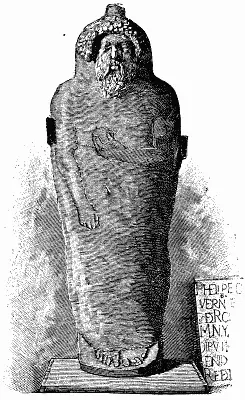
Lebanon's diverse population, composed of different ethnic and religious groups, has further contributed to the country's lively festivals, successful musical styles and literature as well as their rich cuisine - and numerous violent clashes among different religious and ethnic groups. Lebanese society is similar to certain cultures of Mediterranean Europe. Not only is Lebanon a distinctive fusion of Christian and Muslim traditions, it serves as the European gateway to the Middle East as well as the Arab gateway to the Western World.
Art
Beirut has long been known, especially in a period immediately following World War II, for its European-style art and intellectualism. In visual art, painting is varied and encouraged in Lebanon. French surrealists, cubists, and impressionists have influenced Lebanese artists, who add an oriental touch. Moustapha Farroukh and Alfred Bassbouss are famous, as is Charles Khoury. Traditional pottery-making is popular in the coastal towns. Local crafts are encouraged and numerous markets specialize in selling traditional art objects to tourists.
Several international festivals are held in Lebanon, featuring world-renowned artists and drawing crowds from Lebanon and abroad. Among the most famous are the summer festivals at Baalbek, Beiteddine, and Byblos. Beirut in particular has a vibrant arts scene, with numerous performances, exhibits, fashion shows, and concerts held throughout the year in its galleries, museums, theaters, and public spaces.
Clothing
European style clothes are worn in the cities. In poorer Muslim areas, one may still find the chador (the veil women wear). In rural areas, women sometimes wear traditional colorful skirts and men wear a traditional baggy trousers.
Etiquette
Manners are important and influenced by French etiquette. Strangers and acquaintances alike greet each other usually using French terms, such as bonjour, bon soir, and pardon. Hospitality is important.
Food
Lebanese cuisine is shared by Egypt, Syria, Turkey, Greece and Cyprus. It is considered to be a balanced, healthy diet. The Lebanese enjoy eating food from different regions. Fast food has gained widespread popularity, especially among the Lebanese youth.
The Lebanese national dish is the kibbe, a meat pie made from finely minced lamb and burghul wheat. The national drink is arak, a strong anise-flavored liquor made from fermented grape juice. It is usually drank with water and ice, which turns the clear liquid milky-white, and always accompanies food.
Traditional Lebanese meals begin with a wide array of mezzeâ small savoury dishes, such as dips, salads, pastries, and vegetables. The mezze are typically followed by a selection of grilled meats and fish. In general, meals are finished with Arabic coffee and fresh fruit, though sometimes a selection of sweets will be offered as well.
As with most Mediterranean cuisines, pita bread is a staple, while hummus (a chick pea dip), fool (a fava bean dip), and other bean dishes are popular. Rice is nearly a staple, pasta is popular, and salted yogurt is common in many dishes. Red meat and chicken are common but are usually eaten as part of a dish. Muslims consume soup, fatteh (a chick pea and yogurt dish), and karbooj (a nut-rich pastry) as an evening meal during the fasting month of Ramadan. During Lent, Christians eat meatless dishes.
M'jadra, a thick stew of onions, rice and lentils, is often considered a poor man's food and is eaten around Lent by Lebanese immigrants to the United States. It is never served to company by traditional Lebanese families.
Foreign cuisines â especially French, Italian, American, and Asian â are all easily available at restaurants of internationally-renowned wineries, which are mostly located in the fertile Beqaa Valley. These include Chateau Ksara, Chateau Kefraya, Chateau Musar, and many others. The most common Lebanese beer is Almaza, which is often enjoyed at the beach on a hot summer day.
Literature
In literature, Gibran Khalil Gibran is known to be one of the world's famous writers, particularly known for his book The Prophet, which has been translated into more than 20 different languages. Lebanon has a long history of poets and novelists, who write in Arabic as well as French and sometimes English. Oral literature is preserved in villages, especially by way of the zajal, a form of poetic contest in the Lebanese dialect.
Music
Music has played an important role in Lebanese cultural and religious traditions for millennia. In addition to the voice, traditional music incorporates instruments such as the oud, the derbake (a kind of drum also known as the tabla), and the ney. The Lebanese National Higher Conservatory of Music is the heart of the classical music world in Lebanon, and home to both the Lebanese National Symphony Orchestra and the Lebanese National Orchestra for Oriental Arabic Music.
Several singers emerged in a period immediately following World War II, most famously including Fairuz, Nasri Shamseddine, and Marcel Khalife an activist folk singer and oud player. During the 15-year civil war, most of the Lebanese music stars moved to Cairo or Paris, with a large music scene in Beirut only returning after 1992. Modern stars include Diana Haddad, Nawal Al Zoghbi, Najwa Karam, Haifa Wehbe, Rola Saad, Elissa, Ragheb Alama, Walid Toufic, Wael Kfoury, Amal Hijazi, Nancy Ajram, Melhem Zein, Fadel Shaker, The 4 Cats and Assi El Hillani.
The underground music scene is equally vibrant, spearheaded by rock-pop duo Soap Kills but expanding to include a number of groups from a wide array of genres. Underground Arab hip hop groups, such as Rayess Bek and Kitaayoun in particular are growing in popularity and alternative Lebanese rock as Meen. The annual Fête de la Musique, held in late June, brings the whole country out for organized and spontaneous underground concerts.
Sports
Because of Lebanon's unique geography, both summer and winter sports thrive in the country. In fact, in fall and spring it is sometimes possible to engage in both in one day, skiing in the morning and swimming in the Mediterranean during the afternoon.
Lebanon boasts six ski resorts, with slopes suitable for skiers and snowboarders of all ages and levels of experience. Off-slope, there are many opportunities for cross-country skiing, snowshoeing, and snowmobiling.
In the summer, ski lifts can be used to access some of Lebanon's best hiking trails, with panoramic views stretching as far as Cyprus to the west and Syria to the east on clear days. Canoeing, cycling, rafting, climbing, swimming, sailing and spelunking are among the other common leisure sports in Lebanon. Adventure and extreme sports are also possible throughout the country.
At the competitive level, basketball and football are among Lebanon's most popular sports. In recent years, Lebanon has hosted the Asian Cup and the Pan-Arab Games. The country was to host the Winter Asian Games in 2009. To meet the needs of these international competitions, Lebanon maintains state-of-the-art athletic facilities, which in turn encourage local sporting activities. Lebanon sends athletes to both the winter and summer games of the Olympics and Special Olympics.
The Beirut International Marathon is held every fall, drawing top runners from Lebanon and abroad. Shorter races are also held for youth and less serious competitors. Race day is promoted as a fun, family event, and it has become a tradition for many to participate in costumes or outlandish clothing.
Notes
- â Lebanon's Constitution of 1926 with Amendments through 2004 Retrieved January 11, 2025.
- â 2.0 2.1 CIA, Lebanon World Factbook. Retrieved January 11, 2025.
- â 3.0 3.1 3.2 3.3 World Economic Outlook Database, October 2023 Edition. (Lebanon| International Monetary Fund. Retrieved January 11, 2025.
- â Gini Index - Lebanon World Bank. Retrieved January 11, 2025.
ReferencesISBN links support NWE through referral fees
- Ellingham, Mark. World Music: The Rough Guide, Vol. 2- Latin and North America, Caribbean, India, Asia & Pacific. â Rough Guides, 2000. ISBN 1858286360
- Fabbri, Patrizia. The Golden Book of Lebanon. Florence, Italy: Bonechi, 2001. ISBN 8847605520
- Fisk, Robert. Pity the Nation: The abduction of Lebanon. New York: Atheneum, 1990. ISBN 0689121059
- Holst, Sanford. Phoenicians: Lebanon's Epic Heritage. Los Angeles, CA: Cambridge & Boston Press, 2006. ISBN 1887263306
- Karsh, Efraim. The Arab-Israeli Conflict: The Palestine War 1948. Osprey Publishing, 2002. ISBN 1841763721
- Norton, Augustus R. Amal and the Shiʻa: Struggle for the soul of Lebanon. Austin: University of Texas Press, 1987. ISBN 029273039X
- Riley-Smith, Jonathan (ed.). The Oxford Illustrated History of the Crusades. Oxford: Oxford University Press, 1995. ISBN 0198204353
- Salibi, Kamal S. A House of Many Mansions: The history of Lebanon reconsidered. Berkeley: University of California Press, 1988. ISBN 0520065174
External links
All links retrieved March 11, 2025.
- Lebanon World FactBook
- Lebanon Countries and Their Cultures
- Lebanese Republic Central Administration for Statistics
- Lebanon World Heritage Sites
- Al-Bustan Festival
- Lebanon Human Rights Watch
- Lebanon US Department of State
- Lebanon country profile BBC
Credits
New World Encyclopedia writers and editors rewrote and completed the Wikipedia article in accordance with New World Encyclopedia standards. This article abides by terms of the Creative Commons CC-by-sa 3.0 License (CC-by-sa), which may be used and disseminated with proper attribution. Credit is due under the terms of this license that can reference both the New World Encyclopedia contributors and the selfless volunteer contributors of the Wikimedia Foundation. To cite this article click here for a list of acceptable citing formats.The history of earlier contributions by wikipedians is accessible to researchers here:
- Lebanon history
- Geography_of_Lebanon history
- Beirut history
- Hezbollah history
- History_of_Lebanon history
- Economy_of_Lebanon history
- Demographics_of_Lebanon history
- Culture_of_Lebanon history
- Education_in_Lebanon history
- Lebanese_cuisine history
The history of this article since it was imported to New World Encyclopedia:
Note: Some restrictions may apply to use of individual images which are separately licensed.


